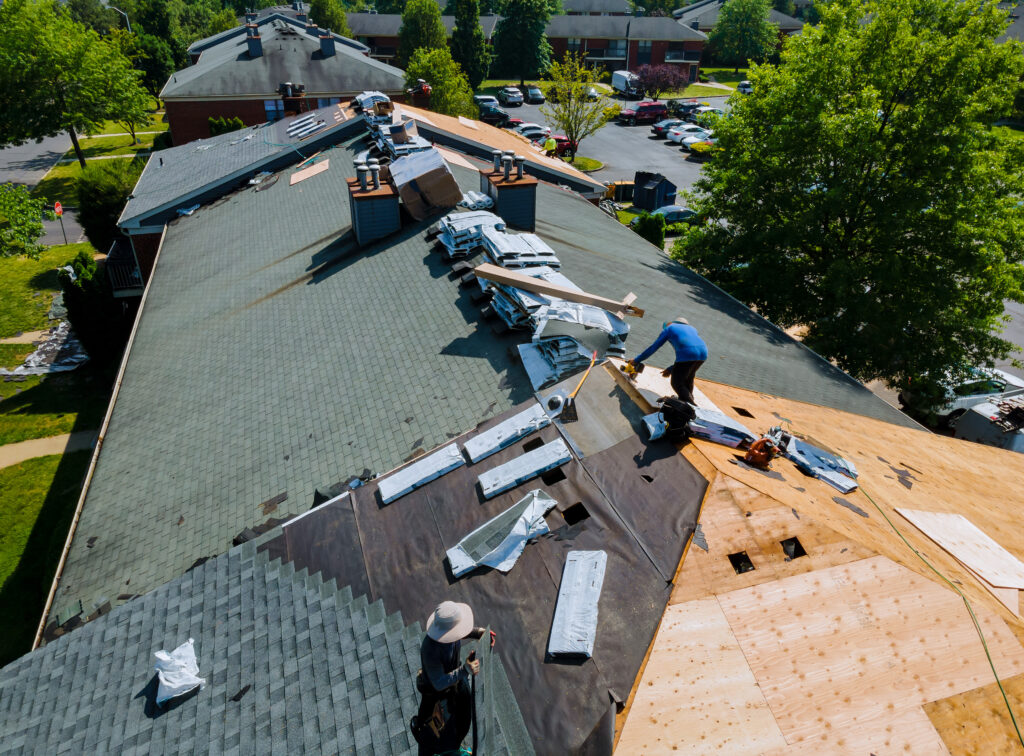The roofing market offers dozens of apps, platforms, and tools that promise to solve every problem your business faces. Estimating apps, CRMs, project trackers, and billing systems all compete for your attention and budget. Choosing the right roofing software for contractors feels overwhelming when every vendor claims their solution is perfect for your needs.
Most roofing contractors know they need better systems but struggle to figure out which tools actually deliver value. Should you buy separate apps for different functions or invest in one platform that handles everything? This guide helps you make smart decisions that improve your roofing business without breaking your budget or overwhelming your team.
Understanding Your Current Roofing Software Needs

Before evaluating different tools, you need to understand what problems you want to solve. Most roofing contractors face similar challenges as they grow their operations. Manual processes take too much time, information gets lost between team members, and customer communication becomes inconsistent.
Make a list of your biggest pain points before looking at roofing software options. Are you losing money on inaccurate estimates? Do crews show up at wrong job sites because of poor communication? Are customers calling constantly asking for project updates? These specific problems should guide your roofing software evaluation process.
Quick tip: Roofing companies that identify their top three operational problems before shopping for software make better purchasing decisions and see faster return on investment than those who buy based on feature lists alone.
Budget considerations affect every software decision but total cost includes more than subscription fees. Training time, data migration, and potential productivity loss during implementation all impact your bottom line. Calculate these hidden costs before making final decisions.
Software for Roofing Contractors: Standalone vs Integrated

The industry offers two main approaches to roofing business software. Standalone tools focus on specific functions like estimating or scheduling. Integrated roofing CRM platforms combine multiple functions in one system. Each approach has advantages and disadvantages depending on your roofing business needs.
Standalone apps often excel at specific tasks and cost less than comprehensive platforms. You can choose the best estimating app, the best CRM, and the best project management tool. However, managing multiple apps creates data silos and requires your team to learn different interfaces.
Integrated platforms provide seamless data flow between different business functions. Customer information, project details, and financial data stay connected across estimating, scheduling, and billing. This connectivity prevents errors while saving time on data entry tasks.
Evaluating Software Based on Your Roofing Business Size

Small roofing companies have different needs than large operations with multiple crews and locations. A three-person team can probably handle basic apps and simple workflows. A twenty-person company needs more sophisticated coordination and management capabilities.
Growing roofing businesses face unique challenges when selecting software. You need systems that work now but can scale as you add employees and take on more roofing projects. Choosing software that becomes obsolete in two years wastes money and disrupts operations.
Enterprise-level features become important for larger roofing contractors handling commercial roofing projects and multiple locations. Advanced reporting, role-based permissions, and integration capabilities support complex operations that basic apps cannot handle.
Roofing Industry Considerations for Software Selection

The roofing business has unique requirements that generic business software cannot address effectively. Weather affects scheduling more than most industries. Material costs fluctuate frequently. Safety regulations require specific documentation and training records.
Industry-specific features make software more valuable for roofing contractors than generic alternatives. Aerial measurement integration, weather tracking, and supplier connections provide capabilities that general business apps lack. These specialized features often justify higher costs through improved efficiency.
Compliance requirements affect software selection for roofing companies working on commercial projects or in regulated markets. Some platforms include features for permit tracking, safety documentation, and insurance compliance that help avoid legal problems and maintain professional standards.
Essential Features Every Platform Should Include

Certain capabilities are essential regardless of your roofing company size or focus. Contact management keeps customer information organized and accessible. Estimate creation tools should produce professional proposals quickly. Basic job tracking helps monitor project progress and completion status.
Mobile functionality allows your roofing team to access information and update progress from job sites. Field crews need to view project details, communicate with the office, and document completed work without returning to headquarters. Mobile access improves efficiency while keeping everyone informed.
Integration capabilities determine how well different business functions work together. Your estimating tool should connect with project management and billing systems. These connections prevent errors while saving time on administrative tasks that add no value for customers.
Roofing Jobs Management and Workflow Optimization

Effective job management starts with clear workflows that everyone understands and follows. Software should support your preferred processes rather than forcing you to change successful methods. Look for platforms that offer customization options for different project types and business models.
Task assignment features help coordinate work across multiple job sites and crew members. Visual scheduling tools show who is working where and when. These capabilities prevent conflicts while ensuring adequate staffing for each project phase.
Progress tracking provides visibility into project status without requiring constant phone calls or site visits. Automated updates keep office staff and customers informed about completion percentages and timeline adherence. This transparency improves customer satisfaction while reducing administrative overhead.
Mobile App Capabilities for Field Operations

Modern roofing operations require mobile access that works reliably from any job site. Your roofing app should provide essential functions without requiring constant internet connectivity. Offline capabilities ensure productivity even in areas with poor cellular coverage.
Photo documentation features help track work progress and support quality control efforts. Before and after pictures provide visual proof of completed work while creating records for warranty and insurance purposes. Easy photo sharing keeps customers informed while protecting your business interests.
Communication tools built into mobile apps help coordinate between field crews and office staff. Instant messaging, status updates, and emergency notifications keep everyone connected without relying on personal phone calls that can be missed or forgotten.
Best Roofing Software Comparison Factors

Feature comparison helps identify which platforms provide capabilities most important for your specific needs. Make a weighted list of essential features versus nice-to-have additions. This prioritization helps focus on solutions that address your most critical business challenges.
User experience affects how quickly your team adopts new software and realizes benefits. Complex interfaces that require extensive training often fail because busy contractors do not have time for lengthy learning processes. Simple, intuitive designs encourage adoption while reducing support requirements.
Vendor reputation and support quality affect long-term satisfaction with any software platform. Choose providers with strong track records in the industry who understand your specific challenges. Good support helps resolve issues quickly while ensuring you maximize platform benefits.
Customer Relationship Management Integration

Managing customer relationships becomes more important as your roofing business grows and competition increases. A roofing CRM helps track all interactions with prospects and customers from initial contact through project completion and follow-up services.
Lead management features help organize and prioritize roofing sales opportunities. Automated follow-up reminders ensure consistent communication with prospects throughout your sales process. These systematic approaches help convert more leads into paying customers.
Service history tracking provides valuable information for future sales and maintenance opportunities. When you know what work each customer has received, you can suggest appropriate follow-up services that provide value while generating additional revenue for your roofing business.
Roofing App Features That Actually Matter

Not all roofing software mobile app features provide equal value for contractors. Focus on capabilities that solve real problems rather than impressive demonstrations that do not translate into daily usefulness. Core functions should work perfectly before considering advanced features.
Estimate accuracy depends on good measurement tools and current material pricing. The best roofing apps include aerial measurement capabilities and integration with supplier databases. These features help create competitive and accurate roofing estimates while maintaining healthy profit margins.
Project coordination features help manage multiple jobs without losing track of details. Schedule synchronization, crew assignments, and material tracking prevent common mistakes that damage customer relationships and reduce profitability.
Did you know? Roofing contractors who prioritize core functionality over advanced features when selecting software report 40% higher satisfaction rates because they focus on tools that solve their biggest daily challenges.
Accurate Measurements and Estimation Tools

Measurement accuracy affects every aspect of roofing projects from initial estimates through final billing. Digital measurement tools reduce errors while providing faster results than manual methods. This accuracy helps win more jobs while protecting profit margins.
Integration with satellite imagery provides quick roof measurements without requiring physical access. These capabilities help respond rapidly to insurance claims and emergency situations. Speed advantages over competitors using manual methods can help secure more roofing jobs.
Calculation automation handles complex area computations, waste factors, and material requirements without manual effort. Automated calculations prevent math errors while ensuring estimates include all necessary components. This accuracy builds customer trust while protecting your business interests.
Instant Roof Estimates for Competitive Advantage

Speed often determines who wins roofing contracts, especially for emergency repairs and insurance work. Instant estimate capabilities help respond to customer inquiries faster than competitors using manual processes. Quick response times create positive first impressions that support higher closing rates.
Template systems provide consistent formatting and professional presentation for all estimates. Standardized proposals include necessary terms and conditions while maintaining your company branding. Professional presentation builds confidence while differentiating your business from competitors using basic formats.
Price optimization features help ensure competitive pricing while maintaining profitable margins. Historical data and market analysis help identify appropriate pricing levels for different project types. This balance helps win more jobs while ensuring sustainable business operations.
Roof Measurement Technology and Integration

Advanced measurement technology transforms how roofing contractors create estimates and plan projects. Aerial imagery, satellite data, and drone integration provide accurate measurements without safety risks or time delays associated with manual methods.
Real-time data access ensures measurements reflect current conditions rather than outdated information. Weather damage, additions, and other changes affect measurement accuracy over time. Current data helps create accurate estimates while avoiding surprises during project execution.
Measurement validation features help verify accuracy before finalizing estimates or ordering roofing materials. Double-checking prevents costly mistakes while ensuring adequate supplies for project completion. This accuracy reduces waste while preventing work delays that damage customer relationships.
Integrated Financing Options for Larger Projects

Customer financing integration helps close larger roofing projects by making them affordable for more homeowners. When you can offer financing during estimate presentations, you expand your potential customer base while increasing average project values.
Automated financing applications streamline the approval process for customers who need payment assistance. Quick approvals help close deals during initial presentations rather than waiting for separate financing arrangements. This convenience improves closing rates while reducing administrative overhead.
Payment processing integration ensures you receive funds quickly once financing arrangements complete. Money flows directly into your accounts without additional paperwork or collection risks. This arrangement improves cash flow while reducing business risks associated with customer financing.
Professional Proposals That Close More Deals

Professional proposal generation creates polished estimates that impress potential customers while providing detailed project information. Well-designed proposals build trust and credibility that help justify premium pricing while differentiating your services from lower-cost competitors.
Customization options allow you to brand proposals with your company logo, colors, and contact information. Consistent branding reinforces your professional image while making estimates easily recognizable. Professional presentation often influences customer decisions as much as pricing considerations.
Contract integration simplifies the transition from estimate to signed agreement. Digital signature capabilities allow immediate contract execution without printing delays. Fast approval processes help secure projects before customers change their minds or accept competitor offers.
Advanced Reporting and Business Intelligence

a man is sawing metal with an angle grinder. Sparks, close up
Performance analytics help identify trends and opportunities that support better business decisions. Revenue analysis, profit margin tracking, and customer satisfaction metrics provide insights into business performance and improvement opportunities.
Cost analysis features help understand which types of roofing projects generate the best returns. Labor efficiency, material costs, and overhead allocation all affect profitability differently across various project types. Detailed analysis helps optimize operations for maximum profitability.
Forecasting capabilities help plan for seasonal variations and business growth. Historical data analysis provides insights into market patterns and resource requirements. This planning supports strategic decisions while helping avoid cash flow problems during slow periods.
According to the National Federation of Independent Business, small businesses that use data analytics to guide decisions grow 15% faster than those relying on intuition alone because they make more informed choices about resource allocation and market opportunities.
Affordable Roof Measurement Reports and Documentation

Detailed measurement reports provide comprehensive documentation for estimates, insurance claims, and project planning. Professional reports build credibility with customers and insurance adjusters while providing reference information for future projects.
Report customization options allow you to include relevant information while excluding unnecessary details. Different audiences need different levels of detail and technical information. Flexible reporting helps communicate effectively with homeowners, insurance adjusters, and building professionals.
Historical record keeping provides valuable reference information for warranty work and future projects. Complete project documentation helps resolve disputes while supporting professional service delivery. Good records protect your business while building customer confidence.
Team Collaboration and Communication Features

Effective communication keeps teams coordinated across multiple job sites without constant interruptions. Built-in messaging systems allow quick information sharing while maintaining permanent records of important decisions and changes.
File sharing capabilities help distribute project documents, photos, and updates efficiently. Everyone needs access to current plans, specifications, and customer requirements. Centralized document management prevents errors while ensuring everyone works with current information.
Task assignment features help coordinate work across different team members and project phases. Clear responsibility assignment prevents confusion while ensuring accountability. Good task management improves efficiency while maintaining quality standards.
Implementation and Training Considerations

Successful software implementation requires careful planning and adequate training for all team members who will use the new system. Different roles require different levels of access and functionality. Tailored training programs help ensure positive outcomes while minimizing productivity disruption.
Data migration from existing systems can be complex but is essential for maintaining business continuity. Work with software vendors to transfer customer information, project histories, and pricing data accurately. Clean data migration prevents future problems while preserving valuable business information.
Change management helps overcome resistance to new systems while building enthusiasm for improved capabilities. Clear communication about benefits and ongoing support during learning periods helps ensure successful adoption. Good change management prevents implementation failure while maximizing software benefits.
For roofing companies that want to understand how comprehensive management systems coordinate all business functions, learn more in our guide about The Best Roofing Management Software for Growing Teams.
Common Implementation Mistakes to Avoid

Rushing implementation without adequate planning often leads to problems that could be prevented with better preparation. Take time to configure systems properly, train team members thoroughly, and test functionality before going live. Proper preparation ensures smoother transitions and faster benefit realization.
Choosing software based on price alone often results in solutions that do not meet actual business needs. Consider total value including functionality, support, and growth potential rather than just subscription costs. Cheap software often costs more in the long run through productivity loss and replacement expenses.
Ignoring user feedback during evaluation and implementation can lead to poor adoption and system failure. Include team members who will use the software daily in selection and configuration decisions. User input helps ensure chosen solutions actually improve operations rather than creating new problems.
Quick tip: Roofing contractors who involve their entire team in software selection decisions see 60% better adoption rates because employees feel ownership in the decision and understand how the new system will help their daily work.
Frequently Asked Questions
What should I look for when choosing software for my roofing business?
Focus on solutions that address your biggest operational challenges first. Projul offers comprehensive functionality including estimating, project management, customer communication, and financial tracking in one integrated platform. Look for software that scales with your business growth while providing reliable support and training resources.
Is it better to use separate apps for different functions or one all-in-one platform?
For most roofing contractors, integrated platforms like Projul provide better value than multiple standalone apps. All-in-one solutions eliminate data entry between systems, provide seamless information flow, and require learning only one interface. This integration saves time while reducing errors and training requirements.
How do I know if roofing software will actually help my business?
Look for platforms that offer free trials or demonstrations with real project data. Projul provides trial access so you can test functionality with your actual estimates and projects. Measure time savings, accuracy improvements, and customer satisfaction changes during trial periods to evaluate real business impact.
What mobile app features are most important for field crews?
Essential mobile features include offline access to job details, photo documentation capabilities, progress updates, and communication tools. Projul’s mobile app provides all these capabilities while syncing automatically when internet connection is available, ensuring your team stays productive regardless of job site conditions.
How much should I expect to spend on roofing software?
Software costs vary based on features and team size, but calculate total value including time savings and error reduction rather than just subscription fees. Projul offers transparent pricing that scales with your business needs while providing comprehensive functionality that often costs less than multiple separate applications.
Can roofing software integrate with my existing accounting system?
Yes, modern platforms like Projul integrate seamlessly with popular accounting software including QuickBooks to maintain accurate financial records automatically. This integration eliminates double data entry while ensuring your books reflect current project costs and revenues without manual effort.
How long does it take to implement new roofing software?
Implementation time depends on business complexity and data migration requirements, but most teams can start using Projul within one week. We provide comprehensive setup support, data migration assistance, and team training to ensure smooth transitions that minimize productivity disruption.
What kind of support should I expect from software vendors?
Choose vendors offering responsive customer support, comprehensive training resources, and ongoing platform development. Projul provides phone and email support from roofing industry experts who understand your specific challenges and can provide practical solutions quickly.
How do I train my team to use new software effectively?
Start with core users who can become internal champions, then expand training to the full team gradually. Projul offers role-based training that focuses on features most relevant to each team member’s responsibilities, making learning more efficient and reducing resistance to change.
What happens if the software doesn’t work out for my business?
Look for vendors offering reasonable trial periods and flexible contract terms. Projul provides trial access and transparent pricing without long-term commitments, allowing you to evaluate functionality thoroughly before making major investments in platform adoption and team training.
Making the Final Software Decision

Cost-benefit analysis should consider both direct costs and potential savings from improved efficiency. Subscription fees, implementation costs, and training time all affect total investment. Compare these costs against time savings, error reduction, and improved customer satisfaction to calculate return on investment.
Trial periods allow you to test software functionality with real projects before making long-term commitments. Use trial periods to evaluate how well platforms integrate with your existing workflows and meet your specific needs. Hands-on testing provides better insights than demonstrations or feature lists.
Vendor evaluation should include support quality, industry experience, and long-term viability. Choose providers committed to ongoing development and customer success in the industry. Strong vendor relationships ensure you receive value from technology investments while accessing new capabilities as they become available.
Understanding the complete range of software options and how they work together helps make informed decisions about your technology strategy. For a comprehensive overview of all available solutions, explore our detailed analysis in The Ultimate Guide to Roofing Contractor Software.
